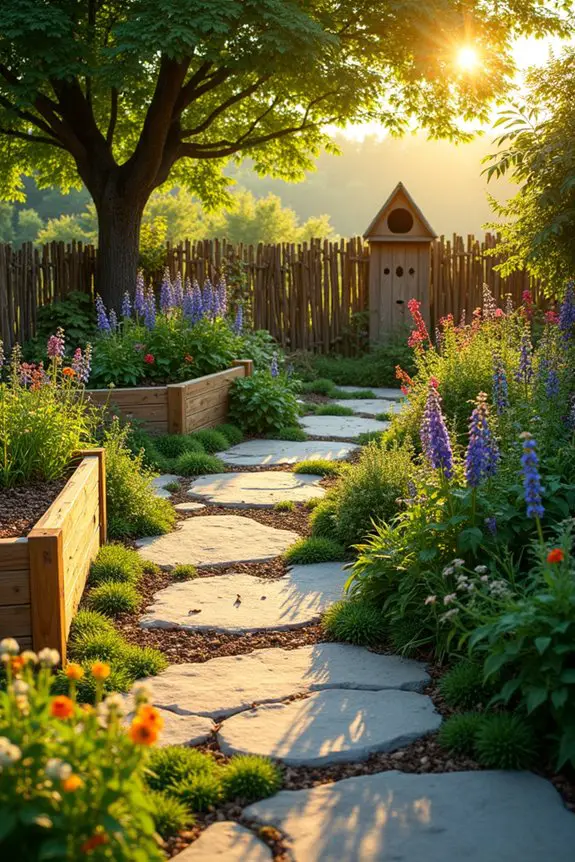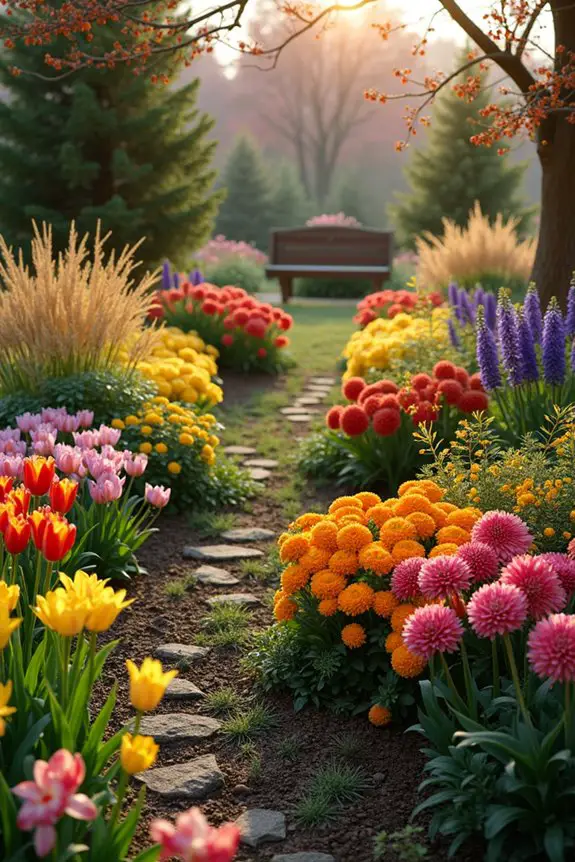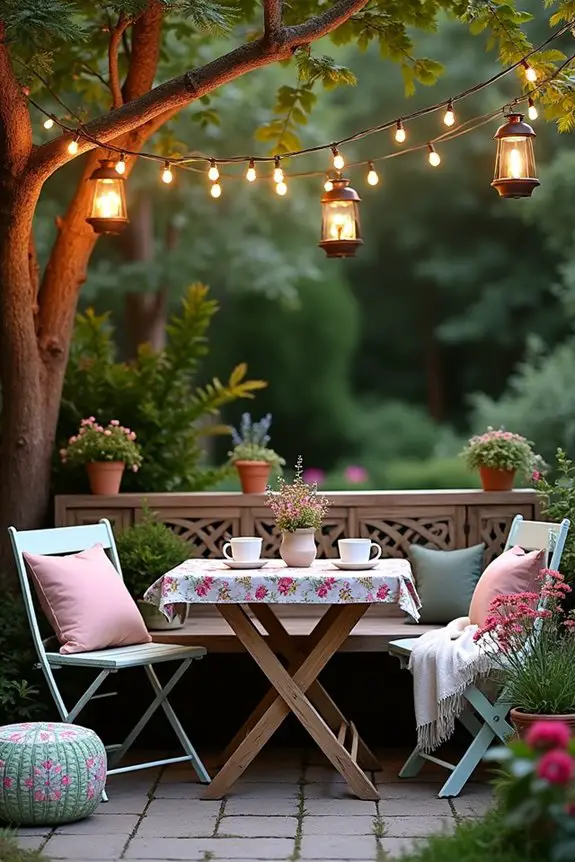Did you know that the right angle or backdrop can turn a simple garden into a magazine-worthy photo op? Seriously, a splash of creativity and a few clever tricks can make a world of difference. You might think it’s just flowers and sunshine, but there’s an art to it. Ready to explore some fun and clever design ideas? Let’s get your garden the spotlight it deserves—it’s time to release your inner photographer.
Eco-Friendly Garden Layouts
When you think about eco-friendly garden layouts, imagine vibrant themed plant groupings that pop with color and charm.
You can create colorful backdrops using sustainable materials, turning your garden into a living canvas that’s good for the earth.
Don’t forget those textured pathways and whimsical touches; they add personality while keeping your garden fun and unique, just like you.
1. Themed Plant Groupings
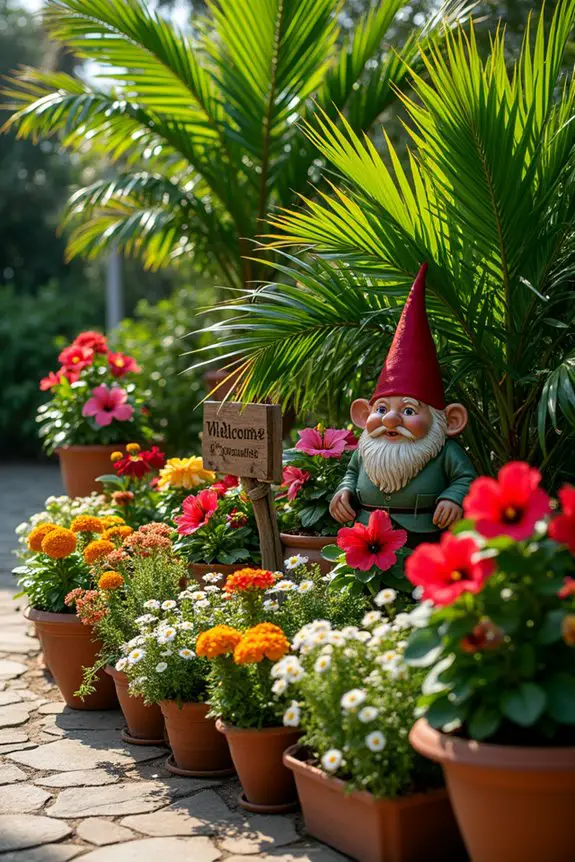
Creating themed plant groupings in your garden is a fantastic way to combine functionality with personality. It’s like throwing a party for your plants! Imagine vibrant colors and textures coming together to create a stunning visual display, while also making it easier for you to care for your plant pals. With a little planning, you can stir the hearts of both plant lovers and everyday garden walkers alike.
To get started, pick a theme that resonates with you. How about a “Tropical Paradise” with ferns, palms, and colorful hibiscus? Or maybe a “Desert Oasis” featuring succulents, cacti, and sandy tones? The choices are endless, so let your imagination run wild. An ergonomic hand trowel can make planting and arranging these themed groupings even more comfortable and efficient.
Once you have your theme, collect plants that not only complement each other but also thrive in similar conditions. This makes watering, sunlight exposure, and care much easier for you. Can you smell the sweet success already?
Here’s a little secret: use pots of different heights for visual interest. You can create layers by placing taller plants in the back and shorter ones in the front. It’s like arranging a fascinating story with each plant having its role. Don’t be afraid to experiment, and remember—the garden is a reflection of you.
Personal anecdotes? Oh, trust me, I learned the hard way when I placed my tallest sunflower right at the front, blocking everything else. It was a two-foot tall wall of yellow that whispered, “Ain’t nobody seeing the cute little daisies at my feet.”
So, definitely consider heights, my friend. Additionally, incorporating a stirrup scuffle hoe into your gardening routine can make maintaining those perfect plant groupings a breeze.
Don’t forget to accessorize your themed group! A quirky garden gnome or a rustic wooden sign can enhance the vibe. Whatever speaks to your soul—just sprinkle it in.
2. Colorful Backdrop Arrangements
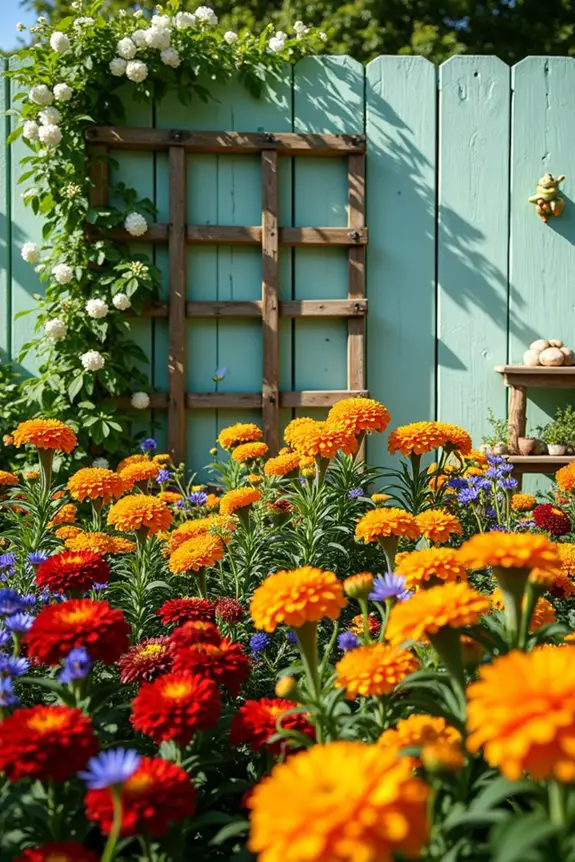
Creating colorful backdrop arrangements in your garden isn’t only a delightful way to beautify your space, but it also serves a practical purpose. Imagine walking into a garden where bright hues and unique textures wrap around you like a warm, cheerful blanket. Plants naturally draw the eye and using colorful backdrops can really help highlight your favorite blooms. It’s like giving your plants a stunning Instagram filter they didn’t know they needed.
To get started, reflect on the colors you’d like to showcase. If you love bright reds and yellows, think about using flowering plants like marigolds, zinnias, or dahlias. For a more serene vibe, opt for soft pastels with lavender, pale pink roses, and white daisies. Pick plants that pair well together but don’t be afraid to throw in a funky plant or two just for fun. Why not introduce a striking blue cornflower amid the warm tones? It’ll be like a little surprise party for the senses.
Placement is key here. Group your colorful plants together but also reflect on the backdrop. If you have fencing or walls, painting them in soft pastels or earthy tones can make your bright plants pop even more. Trust me, I once painted my fence a shocking lime green because I thought it would match my orange marigolds, and let’s just say, it ended up looking like a mishmash of a fruit salad. Stick to colors that create a harmonious vibe instead.
Feeling crafty? You can add visual layers by using trellises draped with climbing plants. Not only does this create height, but it also gives your garden a lush and sophisticated touch. Think of it as adding a fancy hat to your outfit—such a small change can really elevate the whole look. A few decorative stones or garden sculptures can also sprinkle in some personality, just like a quirky hat does for a boring outfit.
Now, all of this does come with some maintenance. Don’t forget to contemplate sunlight and water needs, especially when mixing colors and textures. Make sure the plants you select can thrive together—like roommates who get along splendidly.
And remember, every beautiful garden evolves, just like we do. So be ready to experiment and embrace the wild beauty of nature. After all, isn’t that part of the joy of gardening?
3. Sustainable Material Choices
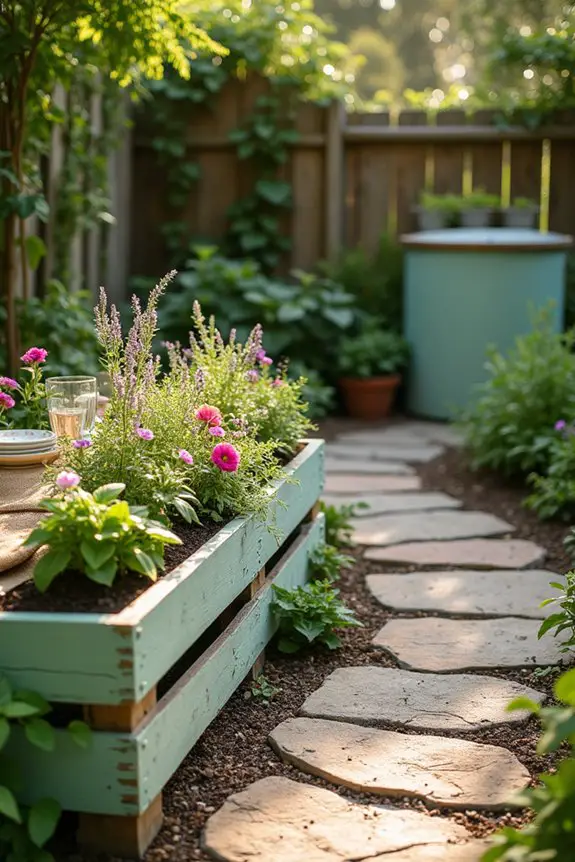
When planning your garden photo shoot, consider using sustainable materials. Not only is this choice great for our planet, but it also creates a warm and inviting vibe that beautifully complements the natural beauty of your plants. Imagine capturing the magic of a lush garden while knowing you’re making eco-friendly choices. It’s like finding a treasure chest full of surprises, and every decision just makes your garden sparkle a little brighter.
First, think about incorporating repurposed materials. Old wooden pallets can be transformed into charming planters, perfect for a whimsical touch. Just a little sandpaper and some weatherproof paint can turn them into eye-catching pieces. Remember my attempt at using pallets? Let’s just say I learned a lot about splinters that day. It’s all part of the journey, right?
Another great option is recycled stones or bricks for borders. These give a rustic charm and help define the garden space beautifully. Plus, they provide excellent drainage. When I installed my stone pathway, I thought I’d just wing it—let’s just say I ended up creating a few more trip hazards than intended. But once I got it right, it turned my garden into the perfect backdrop for photos.
Don’t forget about natural textiles either. Using burlap or hemp as table runners or decoration can add an earthy feel that complements your plants while being kind to the environment. It’s not only stylish but brings a lovely texture that’s perfect for photography. Oh, and when choosing fabrics, check for the biodegradable label. Silk may look luxurious, but it doesn’t quite mesh well with compost.
Lastly, adding elements like a compost bin can blend seamlessly into the aesthetic while being super practical. Just tuck it away in a corner, and you’ll be creating beautiful, nutrient-rich soil for years to come. This practice supports sustainable garden practices, which boost the overall health of your gardening ecosystem. The best part? You get to snap photos without any guilt—good vibes all around. To enhance your garden’s atmosphere, consider using a plant humidity tray that can benefit your greenery and improve overall aesthetics.
4. Textured Pathway Inspiration
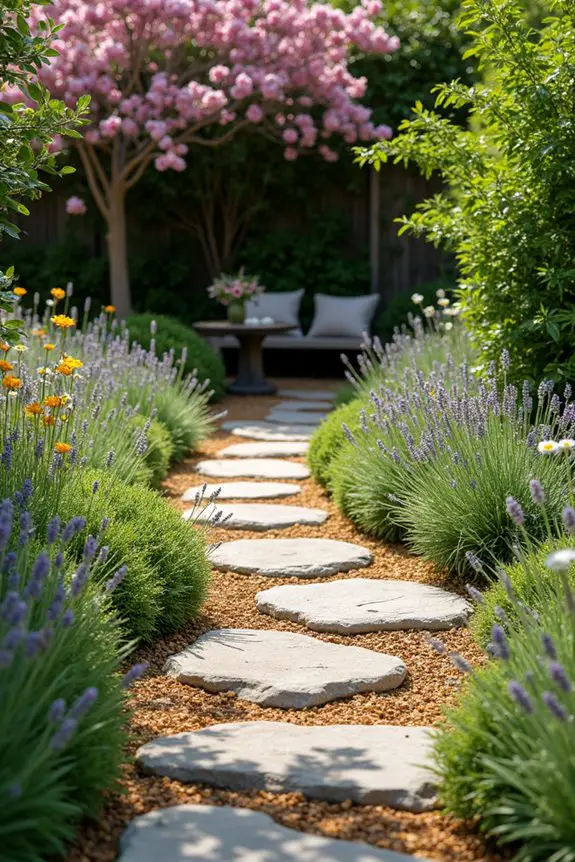
Creating a textured pathway in your garden can completely transform the space, giving it an inviting and rustic charm. Not only does it guide your guests through your garden adventure, but it also adds a playful layer of visual interest for those Instagram-worthy shots. Imagine capturing the lushness of your plants against a backdrop of interesting textures—what a vibe.
Start by considering your existing environment. Are you leaning towards a casual path made of stepping stones, or would you prefer a rustic look with gravel? Both options are eco-friendly, allowing for natural drainage and staying budget-friendly too.
I once tried piecing together a stepping stone path on a cloudy day, thinking I might outsmart the weather. Spoiler alert: I ended up muddy and slipping all over the place. But when it was finally done, it created such a beautiful journey through my garden.
For those who love a DIY challenge, why not collect different-sized stones from your own backyard or nearby riverbank? Lay them out in an organic pattern, ensuring they’re stable but still offer a bit of character. Just remember, not all adventures need to end in scraped knees. Place them carefully, and you’ll have a charming path that tells a story.
If you find yourself drawn to wood, consider a reclaimed wood path. Sure, it might take a bit of elbow grease to sand and seal the planks, but the warm hues of the wood against the greenery create a stunning contrast.
I once made a path like this, and while it didn’t go as planned (let’s just say there were a few too many splinters and misaligned boards), it ended up being a unique, character-filled walkway that I still admire today.
Lastly, think about adding some low-growing plants or ground cover along the edges of your pathway. Something like creeping thyme or moss can create a soft border and draw the eye down the path. An additional burst of color can come from wildflower seed mix bulk, which will attract pollinators and enhance the overall aesthetic of your garden.
And there’s nothing quite like a pathway that bursts to life with color and fragrance, inviting your friends and family to explore every corner of your garden paradise. Oh, and don’t worry if things don’t look picture-perfect right away—it’s all about enjoying the process and learning along the way.
5. Whimsical Element Placement
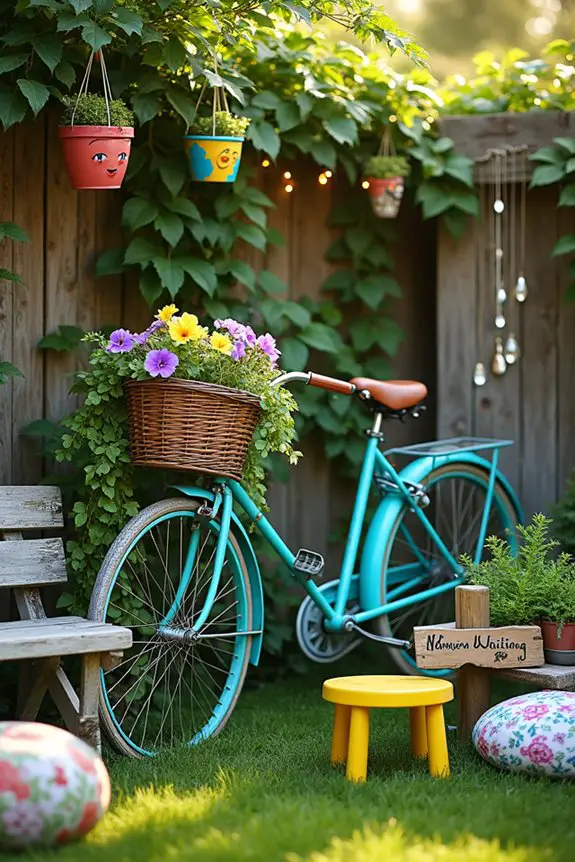
Creating a whimsical garden is like stepping into a fairytale. Envision your space as a canvas, where every plant, structure, or quirky element tells a story. It’s not just about pretty flowers; it’s about crafting a vibe that invites visitors to pause, smile, and maybe even giggle a little. Trust me, nothing sparks joy quite like an unexpected touch—like a colorful garden gnome lounging next to a flowerbed.
Now, what’re some easy ways to add these whimsical elements? Start by incorporating unique decor pieces. I once transformed an old bicycle into a charming plant holder. You can imagine my surprise when I found myself standing back, proud as a peacock, admiring my flower-filled bike.
Just imagine—if a bicycle can bloom, why can’t your garden? Contemplate using colorful pots or hanging lanterns to bring a touch of the enchanted into your outdoor space. They don’t just add charm; they offer a perfect backdrop for some gorgeous photos.
Have you thought about quirky seating arrangements? A mismatched collection of chairs and benches can add character and provoke smiles. Envision this: a vintage garden bench one moment, a bright yellow stool the next. It’s like inviting different personalities to your outdoor party.
What’s better? Each piece can be sourced from thrift stores or upcycled from home. If only my own attempts at reupholstering furniture turned out as well… let’s say that I ended up with more fabric glue on my hands than on the chair!
Don’t forget to contemplate the little details—wind chimes, fairy lights, and hand-painted signs can elevate your space from pretty to truly mesmerizing. My little wind chime crafted from an old ladle is one of my favorite pieces, even if it does sometimes sound like a cooking disaster in the wind.
But every clink and clatter adds a musical note to the atmosphere, making my garden an even more inviting retreat.
6. Seasonal Flower Display Arrangement
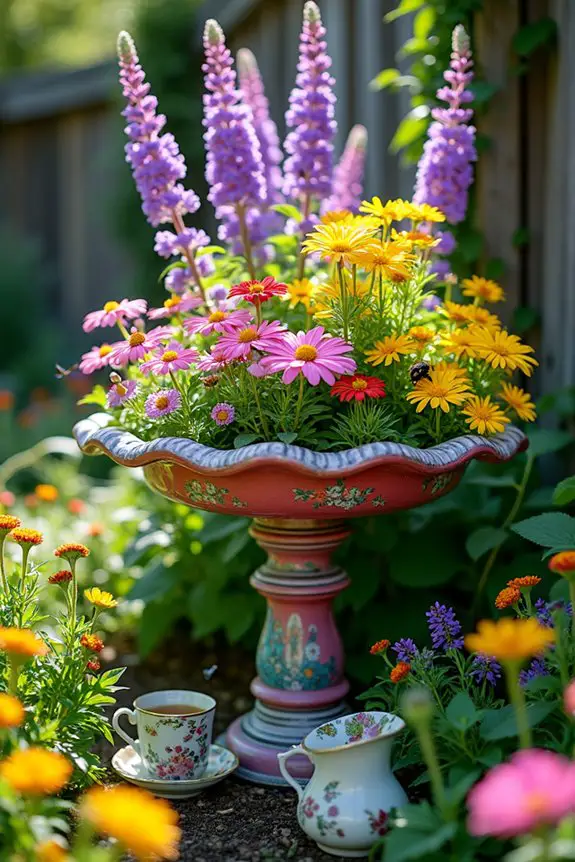
When it comes to brightening up your garden, nothing does the trick quite like a seasonal flower display. These arrangements not only add pops of color but also create a cheerful atmosphere that encourages everyone to enjoy the great outdoors. By rotating your flowers with the seasons, you’re not only embracing nature’s cyclical beauty but also encouraging biodiversity in your garden. Who doesn’t want to be the neighbor with the best blooms, right?
Start with some planning—list out flowers that bloom in different seasons. For spring, think tulips and daffodils. In summer, sunflowers and zinnias steal the show. Fall? How about some cozy mums and asters. By choosing native plants, you help both the environment and your garden thrive.
Just the other day, I discovered that planting marigolds not only brightened my backyard but also kept pesky insects at bay. Talk about a two-for-one deal.
Now, let’s talk arrangement. I love to cluster flowers in groups of odd numbers to create a natural look. Think three or five blooms per spot—they really do know how to show off when they’re together. Layer them by height, with taller flowers in the back and shorter ones in front.
Imagine arranging a mix of shimmering purple verbena in the back, a pop of yellow coreopsis in the center, and delicate pink cosmos in the front. It’s like a dreamy garden parade, and anyone walking by will have no choice but to smile.
Don’t forget the fun and quirky containers! Try using upcycled cans or even old teacups as planters—after all, who doesn’t love a little whimsy?
I once used a broken birdbath as a focal point, filling it with vibrant flowers. Admittedly, it turned out more artistic than planned, but isn’t that the beauty of creativity? Plus, it gives you an excuse to tell friends, “Yeah, that’s just how birds like to hang out in my garden.”
Finally, remember to think about maintenance. Some flowers are high-maintenance and need constant watering, while others will thrive on your neglect. Be honest with yourself about your gardening skills.
I once tried to keep a fancy orchid alive… let’s just say it’s enjoying a much better life in a local greenhouse now. So, choose manageable flowers that fit your lifestyle, and watch your seasonal displays bloom beautifully.
With a bit of love, some planning, and a sprinkle of personality, you’ll have a garden that’s not just eco-friendly but truly enchanting.
7. Layered Lighting Techniques
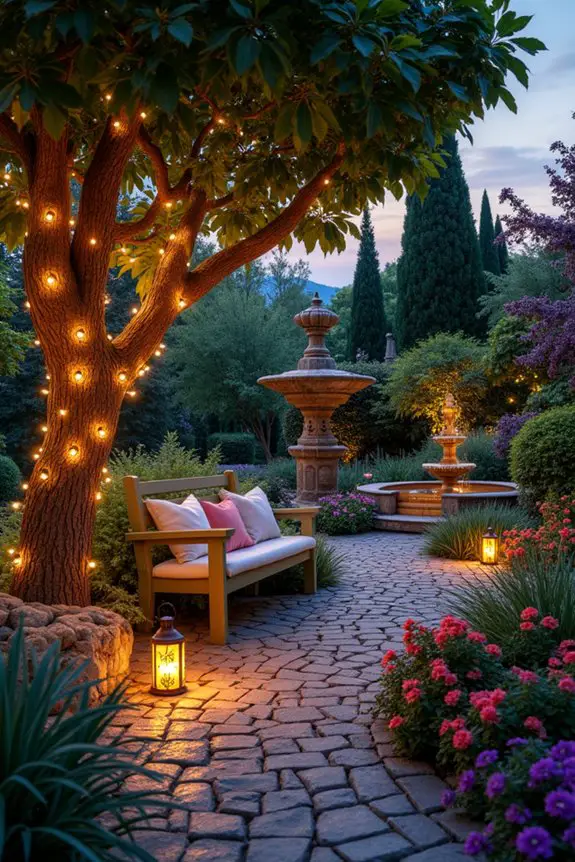
When it comes to enhancing the ambiance of your garden, using layered lighting techniques can transform it into a magical oasis as dusk falls. Not only does lighting serve a practical purpose by illuminating paths and highlighting features, but it also sets a mood that’s cozy and inviting.
Think of your garden as a living canvas; with the right lights, you can paint feelings of serenity and wonder, making it an enchanting spot for evening gatherings or quiet reflection.
Start by mapping out your garden. Identify areas you’d like to highlight, such as beautiful trees, blooming flower beds, or that charming bench you never use—oops, sorry bench. Use string lights in those spots; draping them between branches or around posts can instantly create a warm, magical glow.
I once strung lights around my favorite tree, and it looked like something out of a fairytale. Just don’t forget to secure them properly—nothing says awkward more than a sudden blackout during a garden party.
Next, consider using solar-powered lanterns or fairy lights. These eco-friendly options not only save energy but also add a whimsical element to your design. Place them along pathways to gently guide guests, or cluster them around a sitting area to create an intimate vibe.
Plus, there’s something delightfully satisfying about watching them glow as night falls. Just a word of caution: I once thought it would be fun to DIY my own lanterns, resulting in a slightly charred flower pot. Let’s just say that endeavor went more ‘Edison’ than ‘alight.’
Lastly, add some uplighting for drama. A well-placed spotlight can draw attention to that stunning fountain or emphasize the texture of your garden walls.
Just be mindful of not over-illuminating things; you don’t want your garden to resemble an airport runway. I learned that the hard way when my plan to showcase a lovely flower arch ended up looking like it was auditioning for a reality TV show.
8. Vintage Furniture Arrangements
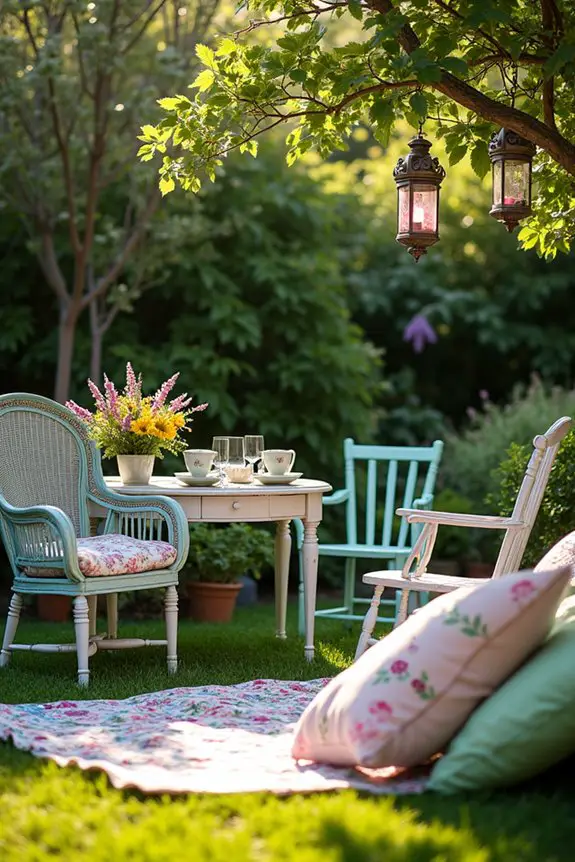
Setting up vintage furniture in your garden can be a game changer. Not only does it add character and charm, but it also creates inviting spots for you and your guests to relax. Imagine sipping lemonade on an old wicker chair under your favorite tree, or sharing laughs around a rustic table that tells stories of summers gone by. It’s all about transforming your garden into an extension of your home while embracing eco-friendly practices.
Start by scavenging for pieces that speak to you—thrift stores, flea markets, and online marketplaces are gold mines for unique finds. Look for items with personality, like an old picnic table or a mismatched set of chairs. I once found an adorable, weathered bench that perfectly fit my garden corner. It’s not just a seat, it’s a conversation starter, even if that conversation sometimes involves me talking to the flowers about their questionable growth habits.
Once you’ve gathered your treasures, focus on arrangement. Group them together to create cozy conversation areas. Think of the arrangements as little nooks throughout your garden where friends can gather or family can play. Maybe an old wrought iron table with a couple of mismatched chairs—the quirky combination adds a playful flair. Just be sure there’s enough space for someone’s elbows while they’re munching on snacks. Trust me, I’ve learned this the hard way when my cousin knocked over a whole plate of cookies trying to squeeze into a too-small space.
Consider using natural elements to enhance the aesthetic. Soft blankets draped over a chair or vintage quilts laid on the grass can really warm up the area. And don’t forget about plants! Incorporating potted herbs or flowers around your furniture can create an even more inviting atmosphere. I once had a few pots of basil on my table, ready for a pesto party, except the only thing they ended up seasoning was my afternoon tea—who knew basil and chamomile don’t mix well?
Finally, don’t be afraid to mix old and new. Pair those vintage chairs with a modern side table or some contemporary art, creating a vibrant contrast that keeps things fresh. It’s like wearing a funky scarf with a classic outfit. Just remember, while your garden may be a reflection of your unique taste, let’s avoid turning it into a cluttered garage sale display. Balance is key, and every piece should feel intentional and inviting.
Embrace the quirky charm of vintage furniture and let your garden flourish into a cozy, stylish haven where relaxation is the only agenda. Happy decorating!
9. Interactive Sculpture Integration
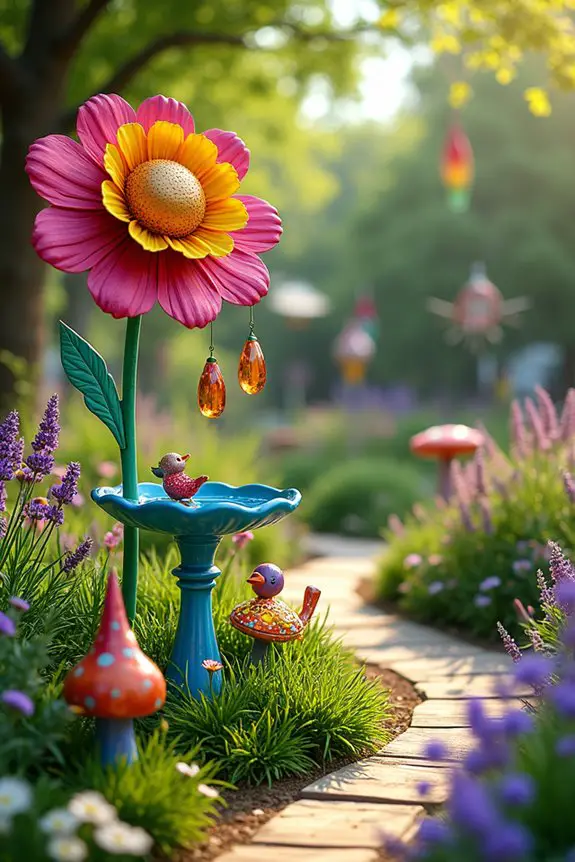
Integrating interactive sculptures into your garden can really elevate the whole experience. Not only do they offer a unique focal point, but they also invite your visitors to engage with the art in a fun way. Imagine this: a whimsical flower that doubles as a wind chime or a colorful birdbath that not only looks good but also attracts feathered friends for a delightful morning concert. It’s about creating a space that sparks joy and conversation while keeping everything eco-friendly.
Start by choosing sculptures made from sustainable materials. Think reclaimed wood, metal, or even ceramic pieces crafted from recycled materials. I once stumbled upon a local artist who created gorgeous birdhouses from old teapots. The way they hung among the branches—a sight to behold. Plus, they served as functional art, giving the birds a stylish home while adding a quirky, cheerful vibe to my garden.
Placement matters too. Aim to have your sculptures in areas where guests are likely to pause and appreciate. Maybe near a seating area or nestled among blooming flowers. You want them to blend into the garden, but also stand out just enough to be noticed. I made the mistake of tucking a beautiful garden gnome behind a bush. Let’s just say, he and the flowers endured a long and lonely summer—no one wants to miss a chance to chuckle at a gnome’s goofy grin.
Don’t shy away from creating a theme. Perhaps a fairy tale garden with mushrooms and whimsical creatures or a nature-inspired space featuring animals and plants that complement each other. My friend decided on a ‘sea’ theme with the ocean creatures made from upcycled glass bottles, and it turned into a mini aquarium vibe in the middle of her backyard. Just be careful; one too many sea stars can make it look like you’ve dropped a recycling bin in the garden.
Lastly, encourage interaction. Allow guests to leave their mark on a sculpture, turn a wheel to hear a sound, or even hide treasures for the energetic kiddos to find. Remember the days when you could get lost in your imagination in a backyard?
Bringing that magic back can turn your garden into a hub of creativity and laughter. So let your garden be a stage where art spins tales and everyone is invited to play.
10. Natural Materials Utilization
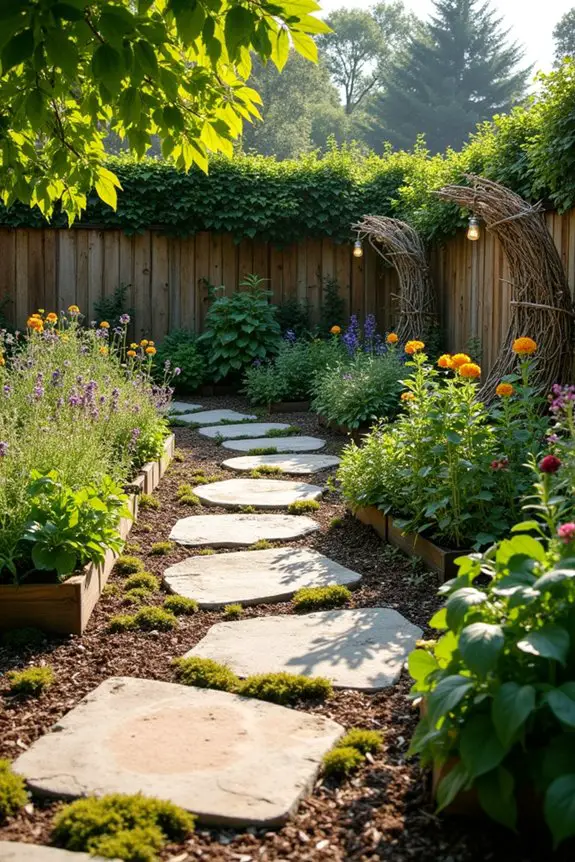
When it comes to creating an eco-friendly garden, using natural materials is a game-changer. Think about it: not only does it blend seamlessly with the beauty of nature, but it also reduces your carbon footprint. Plus, it gives your space that rustic, cozy vibe that feels so inviting. Who doesn’t want a garden that looks like a little slice of the outdoors?
Start by looking around your home or local environment for items that can be repurposed. Old logs, stones, and even bamboo can make for fantastic borders or pathways. I once used a few large, flat stones to create a whimsical stepping path through my garden. At first, I wasn’t sure if it would work, but it turned out to be a charming little wander that made me feel like I was stepping into a hidden fairy kingdom.
It’s all about that slightly wild, natural look—like Mother Nature herself designed it.
Next, consider making your own garden beds using untreated wood or bricks. These materials are durable and if you really want to be trendy, you can build raised beds—they’re easier to maintain, and you can adjust the soil to suit your plants’ needs. I tried building one once, and let’s just say, there may have been a little too much waving from the saw and not enough measuring.
But hey, that quirky, multi-leveled beauty is perfect for growing all those delicious veggies—mistakes and all.
You could also incorporate mulch made from shredded leaves, straw, or grass clippings. Not only does it look good and smell fresh, but it helps keep the weeds at bay while maintaining moisture in the soil. Talk about a win-win situation.
I remember laying down some homemade mulch one afternoon, and while it didn’t all go as planned (hello, scattered leaves), the end result was a garden that looked well-loved and cared for—even if it was just barely held together.
Finally, don’t forget about incorporating natural fencing! Think twigs, branches, or even simple trellises made from sticks. By weaving something together, you create a boundary that not only defines your space but also adds an organic element that feels less harsh than metal or plastic.
My own attempt at a twig fence looked like a scene from a lumberjack’s dream, but it surprisingly added character to my garden, making it the perfect backdrop for those Instagram snaps.
Camera Angles for Best Shots
You’d think capturing the perfect garden shot is all about the flowers, but the camera angles can make or break your photos too.
Experiment with different perspectives—get low, capture those delicate petals from ground level. Trust me, you’ll be amazed at how dramatic those shots can look.
Ever tried shooting from above? It gives a fresh spin on those garden photoshoot ideas. Don’t be shy about tilting your camera, either; a slight angle can add a touch of whimsy.
Remember to include pathways and benches in the frame—they lead the eye.
And, hey, don’t stress if a shot flops. We’ve all had those “oops” moments. Just keep snapping and laughing at yourself; it’s the fun that counts.

